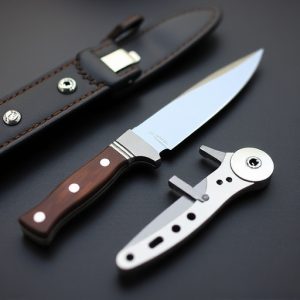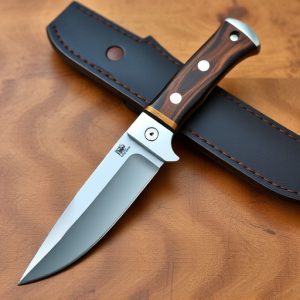Mastering Fixed Blade Knives: Sharpeners for Optimal Performance
Fixed blade knives, durable and precise tools for specific tasks like hunting, camping, or culinary…….
Fixed blade knives, durable and precise tools for specific tasks like hunting, camping, or culinary arts, require understanding their unique features to select the ideal design. Regular sharpening with a suitable sharpener is crucial for optimal performance, safety, and longevity, extending the knife's lifespan. When purchasing a sharpener, consider knife types, skill level, and intended frequency, evaluating construction quality and safety features. Mastering sharpening techniques ensures top condition, enhanced performance, longer life, and safer use for fixed blade knives for sale.
“Unleash the full potential of your fixed blade knife with our comprehensive guide. Explore the unique features and popular types of these versatile tools available for sale, from hunting to camping. Discover why a dedicated fixed blade knife sharpener is an essential companion for maintenance, ensuring your blade remains razor-sharp. Learn about crucial factors to consider before choosing the perfect sharpener, followed by a step-by-step guide to mastering the art of sharpening effectively.”
Understanding Fixed Blade Knives: Their Unique Features and Popular Types for Sale
Fixed blade knives, as the name suggests, feature a stationary blade that does not fold away, setting them apart from their retractable counterparts. These knives are renowned for their durability and precision, making them indispensable tools for various tasks, from outdoor adventures to culinary creations. Understanding their unique design and features is crucial when choosing the right one from the vast array of fixed blade knives for sale.
Popular types include hunting knives, designed with a sturdy build and sharp blades for field use; camping knives, versatile and compact for outdoor exploration; and chef’s knives, featuring various blade shapes and sizes optimized for different cutting tasks in the kitchen. Each type caters to specific needs, ensuring users find the perfect fixed blade knife that aligns with their intended purpose.
The Role of a Fixed Blade Knife Sharpener: Why It's Essential for Maintenance
A fixed blade knife sharpener plays a pivotal role in maintaining the sharpness and longevity of fixed blade knives for sale. Unlike their folding counterparts, fixed blades require specialized care due to their design and constant use. Regular sharpening is not just about convenience; it’s a crucial aspect of knife maintenance that ensures optimal performance and safety. Over time, even the sharpest edge can dull, leading to reduced cutting efficiency and potential accidents.
Investing in a reliable fixed blade knife sharpener allows users to keep their knives in top condition. These tools are designed to restore and maintain the critical angle and edge geometry of fixed blades, ensuring each cut is as precise and clean as the last. Proper sharpening not only enhances cutting ability but also prolongs the knife’s lifespan, making it a must-have accessory for any serious knife enthusiast or professional chef.
Choosing the Right Fixed Blade Knife Sharpener: Factors to Consider Before Purchase
When considering a fixed blade knife sharpener purchase, several key factors come into play to ensure you select the best tool for your needs and preferred knife types. First, determine the type of fixed blade knives you most often use or plan to own. Different designs, such as hunting, camping, or chef’s knives, may have unique blade geometries that require specific sharpening angles and techniques. Thus, look for a sharpener accommodating these variations.
Next, evaluate your skill level and intended sharpening frequency. For occasional sharpeners, a simple and user-friendly guide system might suffice. However, frequent sharpeners or those seeking precision might prefer advanced systems offering more control and consistency. Additionally, consider the sharpener’s construction quality, ease of cleaning, and any safety features to ensure both effectiveness and longevity, especially when shopping for fixed blade knives for sale.
Step-by-Step Guide: Using a Fixed Blade Knife Sharpener Effectively
Using a fixed blade knife sharpener effectively is a skill every owner of these versatile tools should master. Here’s a step-by-step guide to help you maintain your fixed blade knives for sale and keep them in top condition.
1. Prepare Your Workspace: Find a flat, stable surface where you won’t mind a bit of debris. Place the sharpener on this area and ensure it’s secure. Gather all necessary tools: your fixed blade knife, the sharpener, and any lubricants or oils recommended by the manufacturer.
2. Assess Your Knife: Before beginning, inspect your fixed blade knife to understand its current sharpness. Test it against a fine-grit stone or another sharp object to get an idea of how much work is required. Remove any debris or dirt from the blade with a soft cloth before starting the sharpening process.
3. Position the Blade Correctly: Proper alignment is key. Place the knife in the sharpener at the recommended angle, usually around 15-20 degrees for most fixed blades. Ensure the edge of the blade makes consistent contact with the sharpening surface throughout the process.
4. Apply Consistent Pressure: As you move the knife back and forth along the sharpener’s surface, maintain a steady pressure. This ensures even wear on both sides of the blade, resulting in a smoother, sharper edge. Avoid applying too much force, as it may damage the sharpener or the delicate blade.
5. Repeat the Process: Depending on the condition of your knife, you might need to pass the blade through the sharpener multiple times, alternating between the coarse and fine sides if your sharpener offers both. Always follow the manufacturer’s instructions for optimal results.
6. Clean and Store: Once satisfied with the sharpness of your knife, wipe it clean with a damp cloth and dry it thoroughly. Re-oil or lubricate the blade as needed to prevent rusting, then store it safely in its sheath or a designated block.


